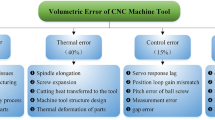Abstract
In the last decades, several process models have been developed for simulation of 5-axis milling cycles, where the simulation results are used for parameter selection or process improvement purposes. However, integrating the process models with milling cycles is not a trivial task especially for tool path modification purposes in 5-axis free-form milling. This is mainly due to the fact that tool path modification requires the machined surface information, i.e. surface location and surface normal vector, to be known. However, this information is not explicitly given in the tool path, i.e. cutter location source (CLS), file. In this paper, a novel and practical approach is proposed to analytically calculate the surface location and surface normal vectors directly from the already generated tool path in the form of CLS file. The proposed approach is applied on representative 5-axis milling cycles, and the results are verified through CAD model comparisons. It is shown that the proposed approach can calculate the machined surface data at a reasonable accuracy depending on the cutter location point density in the tool path file.
Similar content being viewed by others
References
Budak E, Ozturk E, Tunc LT (2009) Modeling and simulation of 5-axis milling processes. CIRP Ann Manuf Technol 58(1):347–350
Ozturk B, Lazoglu I (2006) Machining of free-form surfaces. Part I: analytical chip load. Int J Mach Tools Manuf 46(7):728–735
Ozturk B, Lazoglu I, Erdim H (2006) Machining of free-form surfaces. Part II: calibration and forces. Int J Mach Tools Manuf 46(7):736–746
Zhu R, Kapoor SG, DeVor RE (2001) Mechanistic modeling of the ball end milling process for multi-axis machining of free-form surfaces. J Manuf Sci Eng 123(3):369–379
Fussell BK, Jerard RB, Hemmett JG (2003) Modeling of cutting geometry and forces for 5-axis sculptured surface machining. Comput Aided Des 35(4):333–346
Kim GM, Kim BH, Chu CN (2003) Estimation of cutter deflection and form error in ball-end milling processes. Int J Mach Tools Manuf 43(9):917–924
Eksioglu C, Kilic ZM, Altintas Y (2012) Discrete-time prediction of chatter stability, cutting forces, and surface location errors in flexible milling systems. J Manuf Sci Eng 134(6):061006
Ozturk E, Budak E (2010) Dynamics and stability of five-axis ball-end milling. J Manuf Sci Eng 132(2):021003
Wan M, Kilic ZM, Altintas Y (2015) Mechanics and dynamics of multifunctional tools. J Manuf Sci Eng 137(1):011019
Altintas Y, Kilic ZM (2013) Generalized dynamic model of metal cutting operations. CIRP Ann Manuf Technol 62(1):47–50
Altintas Y, Kersting P, Biermann D, Budak E, Denkena B, Lazoglu I (2014) Virtual process systems for part machining operations. CIRP Ann Manuf Technol 63(2):585–605
Ong TS, Hinds BK (2003) The application of tool deflection knowledge in process planning to meet geometric tolerances. Int J Mach Tools Manuf 43(7):731–737
Lo CC, Hsiao CY (1998) A method of tool path compensation for repeated machining process. Int J Mach Tools Manuf 38(3):205–213
Dépincé P, Hascoët JY (2006) Active integration of tool deflection effects in end milling. Part 2. Compensation of tool deflection. Int J Mach Tools Manuf 46(9):945–956
Ratchev S, Liu S, Becker AA (2005) Error compensation strategy in milling flexible thin-wall parts. J Mater Process Technol 162:673–681
Habibi M, Arezoo B, Nojedeh MV (2011) Tool deflection and geometrical error compensation by tool path modification. Int J Mach Tools Manuf 51(6):439–449
Rao VS, Rao PVM (2006) Tool deflection compensation in peripheral milling of curved geometries. Int J Mach Tools Manuf 46(15):2036–2043
Choi BK (1991) Surface modelling for CAD/CAM. Elsevier, New York
Ho MC, Hwang YR, Hu CH (2003) Five-axis tool orientation smoothing using quaternion interpolation algorithm. Int J Mach Tools Manuf 43(12):1259–1267
Gray PJ, Ismail F, Bedi S (2004) Graphics-assisted rolling ball method for 5-axis surface machining. Comput Aided Des 36(7):653–663
Jun CS, Cha K, Lee YS (2003) Optimizing tool orientations for 5-axis machining by configuration-space search method. Comput Aided Des 35(6):549–566
Beudaert X, Pechard PY, Tournier C (2011) 5-Axis tool path smoothing based on drive constraints. Int J Mach Tools Manuf 51(12):958–965
Chen HP, Kuo HH, Tsay DM (2009) Removing tool marks of blade surfaces by smoothing five-axis point milling cutter paths. J Mater Process Technol 209(17):5810–5817
Lim TS, Lee CM, Kim SW, Lee DW (2002) Evaluation of cutter orientations in 5-axis high speed milling of turbine blade. J Mater Process Technol 130:401–406
Ozturk E, Tunc LT, Budak E (2009) Investigation of lead and tilt angle effects in 5-axis ball-end milling processes. Int J Mach Tools Manuf 49(14):1053–1062
Yigit IE, Lazoglu I (2015) Analysis of tool orientation for 5-axis ball-end milling of flexible parts. CIRP Ann Manuf Technol
Tunc LT, Budak E (2009) Extraction of 5-axis milling conditions from CAM data for process simulation. Int J Adv Manuf Technol 43(5–6):538–550
Author information
Authors and Affiliations
Corresponding author
Rights and permissions
About this article
Cite this article
Tunc, L.T. Rapid extraction of machined surface data through inverse geometrical solution of tool path information. Int J Adv Manuf Technol 87, 353–362 (2016). https://doi.org/10.1007/s00170-016-8439-1
Received:
Accepted:
Published:
Issue Date:
DOI: https://doi.org/10.1007/s00170-016-8439-1




